Visitantes indeseados/Unwanted visitors
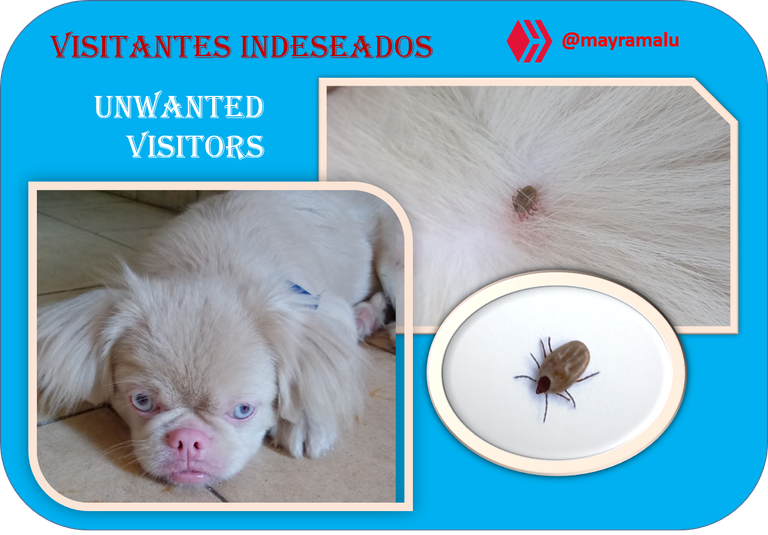
Queridos amigos, en esta oportunidad quiero compartir con ustedes sobre algo muy importante que afecta a nuestras mascotas: las garrapatas.
En mi vida laboral, entre los proyectos en los que he trabajado, ha estado el estudio de las garrapatas donde he participado en el Programa de Control de Garrapatas tanto en Cuba como en Venezuela. Por este motivo me gusta compartir conocimientos que son muy necesarios para todos los que tenemos mascotas como perros y otros animales que se pueden afectar por estos parásitos.
La idea de escribir este post se produjo al encontrar dos garrapatas en el lomo de mi perrito Coqui. En casa tenemos la costumbre de revisarlo diariamente porque sabemos que se puede infestar a pesar de que le aplico periódicamente las dosis de garrapaticidas llamadas pipetas, que son muy efectivas pero no al 100 %. Es que siempre hay la posibilidad de infestación cuando sacamos a pasear a Coqui, cualquier garrapata aprovecha la oportunidad de subirse.
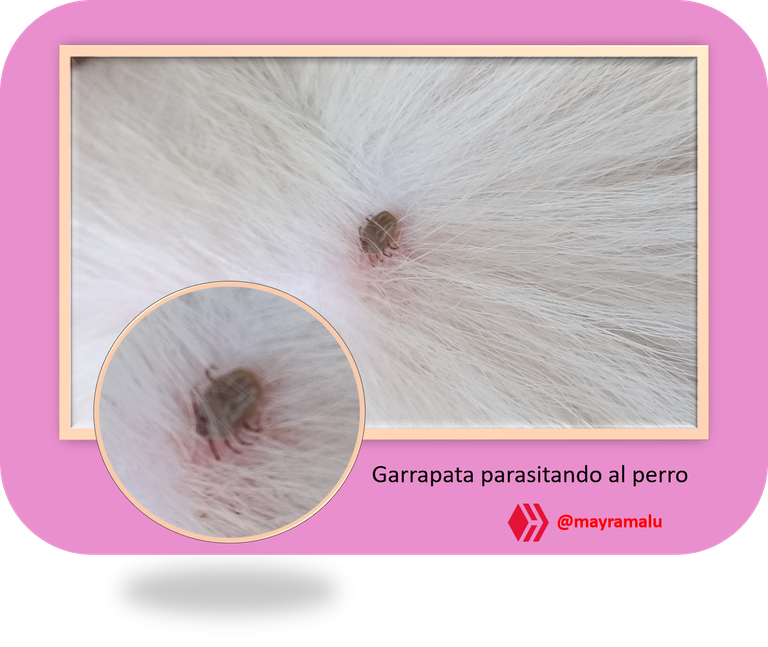
Podemos observar en la foto como la garrapata provoca un enrojecimiento en la zona donde ella introduce parte de su aparato bucal llamado hipostoma para anclarse al cuerpo del animal y alimentarse de la sangre del animal, la cuál es imprescindible para la producción de sus huevos.
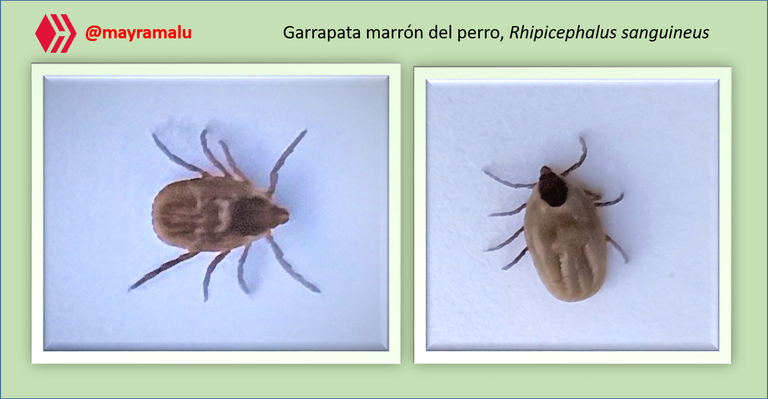
Estas garrapatas son hembras, presentan un escudo en el dorso cerca de la cabeza, el cuerpo se llena de sangre para producir los huevos. Las garrapatas machos son más pequeñas y se mantienen moviéndose por todo el animal a diferencia de las hembras que se anclan en la piel.
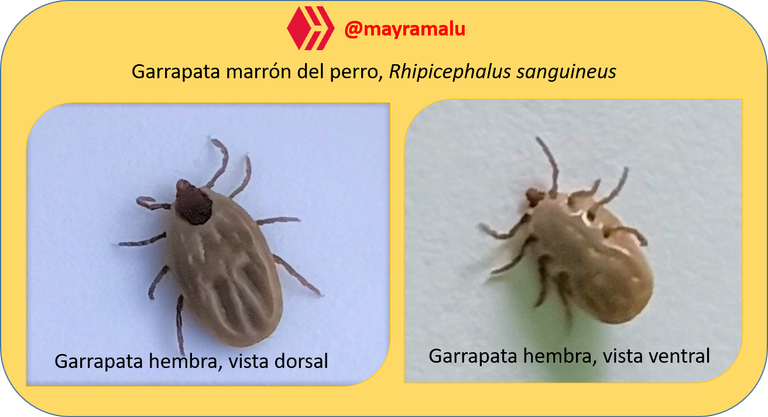
Al sacar la garrapata del cuerpo lo hice de forma que no quedara su hipostoma, dentro del cuerpo de mi perrito ya que podría provocarle una infección o daños en la piel por este motivo.
También quiero comentarles que encontrar una, dos o tres garrapatas en nuestra mascota no es de alarmarse demasiado, es solo una alerta, lo que no podemos permitir es que aumente el nivel de infestación. Este número ínfimo permite que nuestro animal se proteja inmunológicamente. ¡Sí, es cierto! ¿Por qué? Porque si una de esas garrapatas es portadora de algún microorganismo que causa una enfermedad, al ser solo una, permite que se active el mecanismo de defensa, el sistema inmune del perro hace anticuerpos contra ese patógeno e impide que se enferme; además se quedan los anticuerpos para defender de una futura entrada del mismo agente infeccioso.
La clave para garantizar la salud en nuestros animales es garantizar un control en el nivel de infestación de parásitos en general y esto nos permite también controlar los microorganismos infecciosos que son portados por estos parásitos.
Curiosidades de las garrapatas:
- Existen más de 600 especies de garrapatas, una de ellas es la conocida como garrapata marrón del perro.
- La garrapata del perro se llama Rhipicephalus sanguineus y tiene un ciclo de vida denominado ¨ciclo de 3 huéspedes¨ porque ellas hacen cambios y mudas en tres oportunidades diferentes fuera del animal de donde se encuentran parasitando, o sea, se bajan del animal para hacer la muda y luego suben al mismo animal o a otro.
- Pueden alimentarse de cualquier animal vertebrado, incluyendo al hombre.
- La hembra llega a tomar hasta 3 mililitros de sangre en su vida sobre el perro, por este motivo cuando el nivel de infestación en un animal es grande, le puede ocasionar anemia.
- Son transmisoras de enfermedades a los animales que parasitan.
- Cuando la garrapata hembra se repleta de sangre y adquiere la forma de un globo, se baja del animal para buscar un lugar sombrío y húmedo donde depositar sus huevos.
- Una sola garrapata pone entre 3000 y 4000 huevos los cuales son muy fértiles dando lugar a 3000-4000 larvas que suben hacia lo más alto que encuentren. Este fenómeno se llama geotropismo negativo. Esto es debido a que cuando están en el pasto, suben hasta la parte superior de la hierba para esperar que pase un animal de sangre caliente donde subirse y parasitar.
- Son muy resistentes pueden vivir de 3 a 6 meses fuera del animal hasta que encuentran el momento oportuno para parasitar.
Por todas estas razones es que es muy necesario higienizar bien las viviendas, no solo el piso sino también las partes altas, porque las larvas pueden llegar hasta el techo. También es importante mantener el jardín o el patio con la hierba bien corta, especialmente en las zonas de sombra que es donde ellas prefieren poner sus miles de huevos.
Espero que les haya gustado y que les sea útil la información que les brindo con amor.
Fuente
Ciclo
Aquí pueden encontrar muy buena ilustración sobre el ciclo de vida de la garrapata del perro.
AQUÍ/HERE
Les quiero compartir el post de @abneagro, donde explica muy bien las características de las garrapatas
Todo el texto y las fotos presentes en este post son de mi autoría. Las imágenes fueron editadas con CollageLab y Power Point. Mi lengua materna es el español, la traducción al Inglés la realicé con el traductor DeepL.
Muchas gracias por su visita
¡Hasta pronto!

Unwanted visitors
Dear friends, in this opportunity I want to share with you something very important that affect our pets: ticks.
In my working life, among the projects in which I have worked, has been the study of ticks where I have participated in the Tick Control Program both in Cuba and Venezuela. For this reason I like to share knowledge that is very necessary for all of us who have pets such as dogs and other animals that can be affected by these parasites.
The idea of writing this post came when I found two ticks on the back of my puppy Coqui. At home we have the habit of checking him daily because we know that he can be infested even though I periodically apply the doses of the tick killer called pipettes, which are very effective but not 100%. There is always the possibility of infestation when we take Coqui for a walk, any tick takes the opportunity to climb on him.
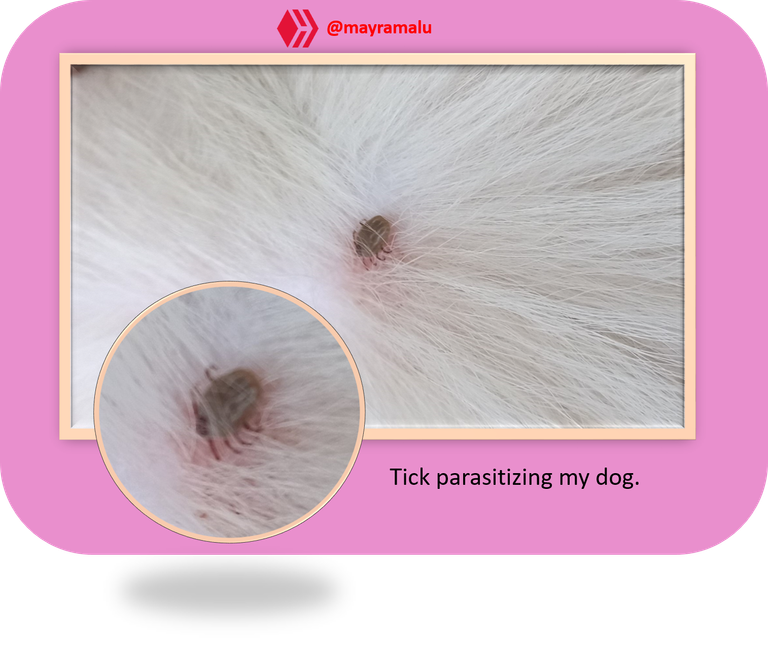
We can see in the photo how the tick causes a reddening in the area where it introduces part of its mouthparts called hypostome to anchor itself to the animal's body and feed on the animal's blood, which is essential for the production of its eggs.
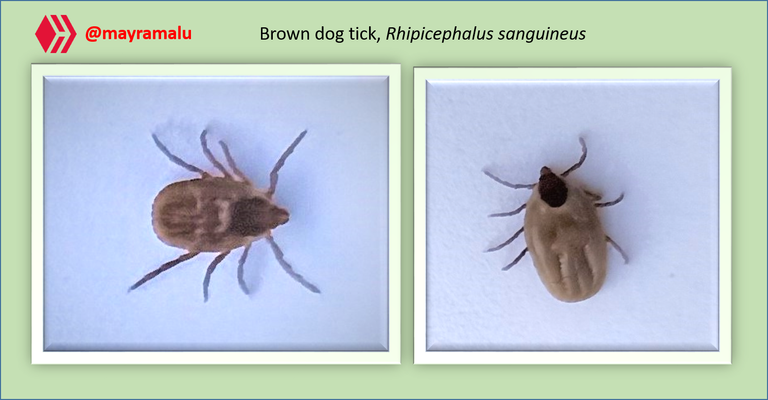
These ticks are female, have a shield on the back near the head, and the body fills with blood to produce eggs. Male ticks are smaller and keep moving all over the animal, unlike females, which are anchored to the skin.
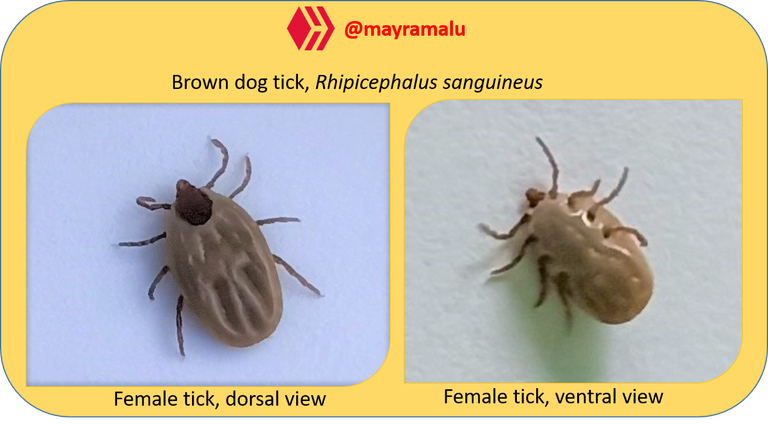
When I removed the tick from the body I did it in a way that its hypostome was not left inside the body of my puppy because it could cause an infection or damage to the skin for this reason.
I also want to tell you that finding one, two or three ticks on our pet is not a cause for alarm, it is just an alert, what we cannot allow is to increase the level of infestation. This tiny number allows our animal to protect itself immunologically. Yes, it is true! Why? Because if one of those ticks is a carrier of some microorganism that causes a disease, being only one, it allows the defense mechanism to be activated, the dog's immune system makes antibodies against that pathogen and prevents it from getting sick; in addition, the antibodies remain to defend against a future entrance of the same infectious agent.
The key to guarantee the health of our animals is to guarantee a control in the level of parasite infestation in general and this also allows us to control the infectious microorganisms that are carried by these parasites.
Curiosities of ticks:
- There are over 600 species of ticks, one of which is known as the brown dog tick.
- The dog tick is called Rhipicephalus sanguineus and has a life cycle called "3-host cycle" because they make changes and molt in three different opportunities outside the animal where they are parasitizing, that is, they get off the animal to molt and then go up to the same animal or to another one.
- They can feed on any vertebrate animal, including man.
- The female can take up to 3 milliliters of blood in its life on the dog, for this reason when the level of infestation in an animal is large, it can cause anemia.
- They are transmitters of diseases to the animals they parasitize.
- When the female tick is full of blood and acquires the shape of a balloon, it gets off the animal to look for a shady and humid place to lay its eggs.
- A single tick lays between 3000 and 4000 eggs which are very fertile and give rise to 3000-4000 larvae that climb to the highest place they can find. This phenomenon is called negative geotropism. This is because when they are in the grass, they climb to the top of the grass to wait for a warm-blooded animal to pass by and parasitize.
- They are very resistant and can live from 3 to 6 months outside the animal until they find the right moment to parasitize.
For all these reasons it is very necessary to sanitize well the houses, not only the floor but also the upper parts, because the larvae can reach the roof. It is also important to keep the garden or yard with the grass well cut, especially in shady areas where they prefer to lay their thousands of eggs.
I hope you liked it and that you find the information I am lovingly providing you with useful.
Source
Life Cycle
Here you can find very good illustration about life cycle of the dog tick.
HERE/HERE
I want to share with you @abneagro's post, where he explains very well the characteristics of ticks.
All the text and photos in this post are of my authorship. The images were edited with CollageLab and Power Point. My native language is Spanish, the translation into English was made with DeepL.
Thank you very much for visiting.
See you soon!

Está súper interesante tu post solo de ver las fotos ese bicho me erizo.
Gracias amigo, sí son terribles. Gracias por tu apoyo, linda noche 🤗😘
😍
Congratulations @mayramalu! You have completed the following achievement on the Hive blockchain And have been rewarded with New badge(s)
Your next target is to reach 3000 upvotes.
You can view your badges on your board and compare yourself to others in the Ranking
If you no longer want to receive notifications, reply to this comment with the word
STOPMuy interesante todo lo que nos cuentas sobre las garrapatas todo una clase magistral y muy necesaria para todos los que tenemos mascotas. Gracias por compartir.
Gracias amiga @babyl por tu comentario. Me alegra que te haya gustado. Juraria que te había respondido 😯 tengo serios problemas de conexión. Un abrazo.
Thanks for your contribution to the STEMsocial community. Feel free to join us on discord to get to know the rest of us!
Please consider delegating to the @stemsocial account (85% of the curation rewards are returned).
You may also include @stemsocial as a beneficiary of the rewards of this post to get a stronger support.
Muchas gracias
Hola Mayra, como siempre muy interesante lo que escribes... que lastima que a Coquito lo visito una garrapata, como bien dices es un visitante no deseado. Muy interesante y curioso lo que detallas sobre las garrapatas, pero las quiero bien lejos. Gracias por compartir y por hacer de cada evento una clase. Besos.
Hello Mayra, as always what you write is very interesting... what a shame that a tick visited Coquito, as you say, it is an unwanted visitor. What you detail about ticks is very interesting and curious, but I want them far away. Thank you for sharing and for making each event a class. Kisses.
Gracias mi amiga, es una lucha constante mantener controladas estas indeseables 😂 pero lo logramos 💪. Me alegra que te haya gustado la clase😃 lindo dia🤗
Hola, muy útil tu post, todos los que tenemos mascotas batallamos contra las garrapatas , por eso es importante el peinado cada 2 o tres días, a mi me ayuda muchísimo, ya que mi perro es chaw chaw y el peinado ayuda a quitar las garrapatas que aún no han llegado a la piel, y por supuesto las revisiones periódicas ayudan muchísimo.
Gracias por tu comentario. Muy cierto lo que dices, el peinado es muy importante, sobretodo los que tienen mucho pelaje. Lindo día🤗
Pasando un poco tarde, pero por aquí dejo mi comentario jeje. Muy acertada y bien descrito todo lo que compartes sobre las molestas garrapatas, es realmente casi imposible librar a las mascotas de estos arácnidos, ya que sus tasas reproductivas son muy elevadas y cualquier entorno natural está cargado de las garrapatas a la espera de que sus huéspedes pasen cerca. Sin embargo, el hacer seguimiento y estar al pendiente de nuestras mascotas nos permite controlar o disminuir el impacto de dichos arácnidos, por esto siempre se deben aplicar cuidados. Te quedaron muy buenas las fotografías Mayra, no sabía que te había tocado trabajar con garrapatas aquí en Venezuela, eso es interesante. Te mando un abrazo.
Gracias amigo tu valoración es muy importante para mí, las fotos están inspiradas en tus post, algo aprendí contigo 😂, me acordaba de ti cuando trataba de que se estuvieran tranquilas para fotografiarlas 🤣. Pues sí, trabaje un año 2014-2015 con el sector campesino en el programa de control de garrapatas del bovino usando el producto Gavac que es producido por nuestro centro. Tengo muchas experiencias de muchos lugares 🤭🤔 por qué será?😜. Otro abrazo.